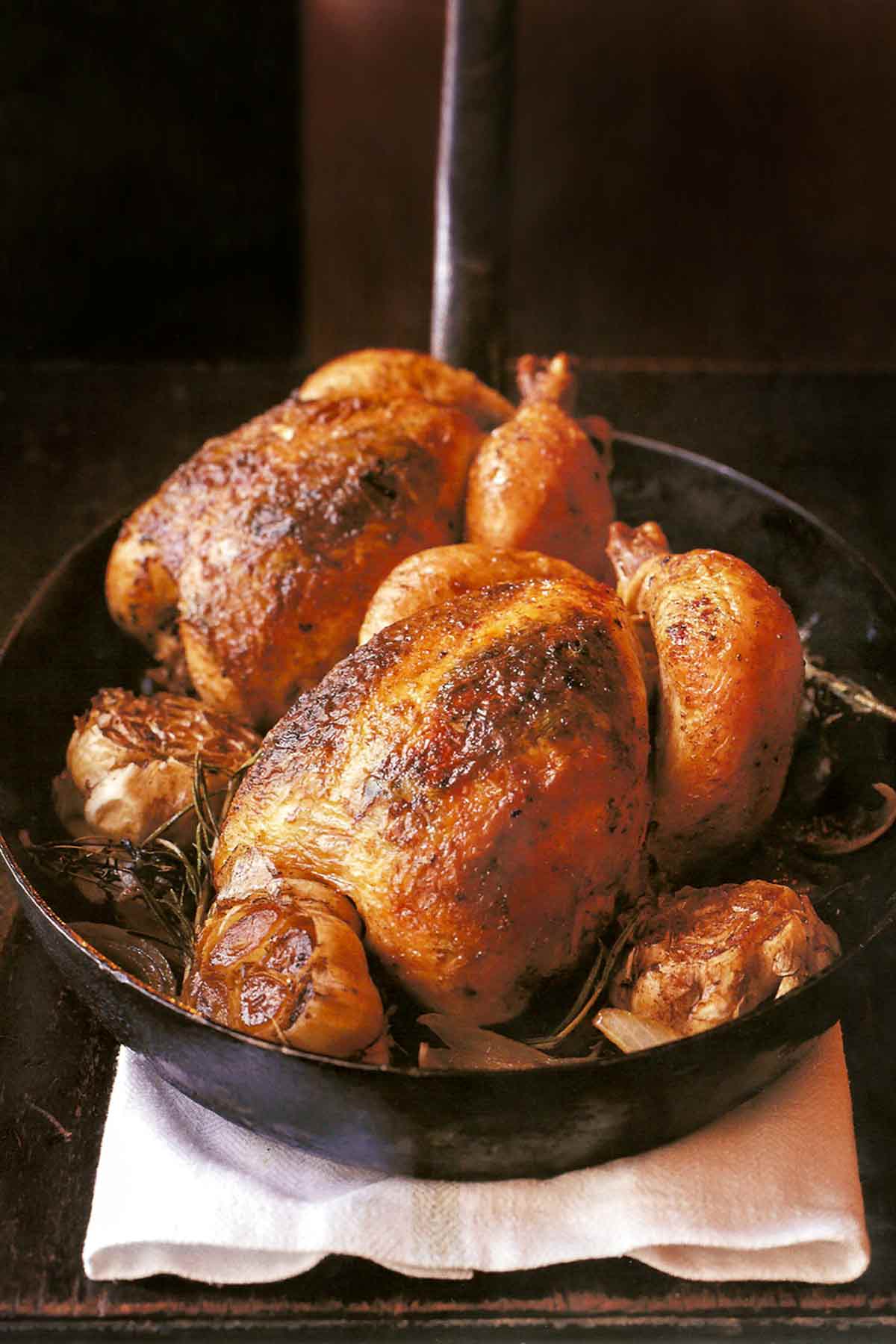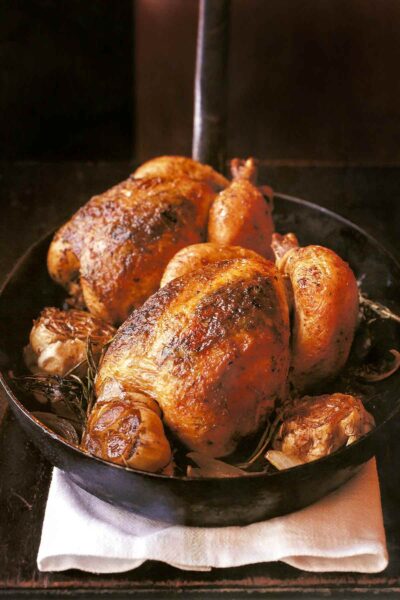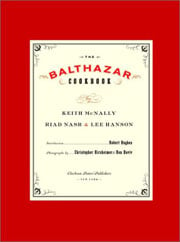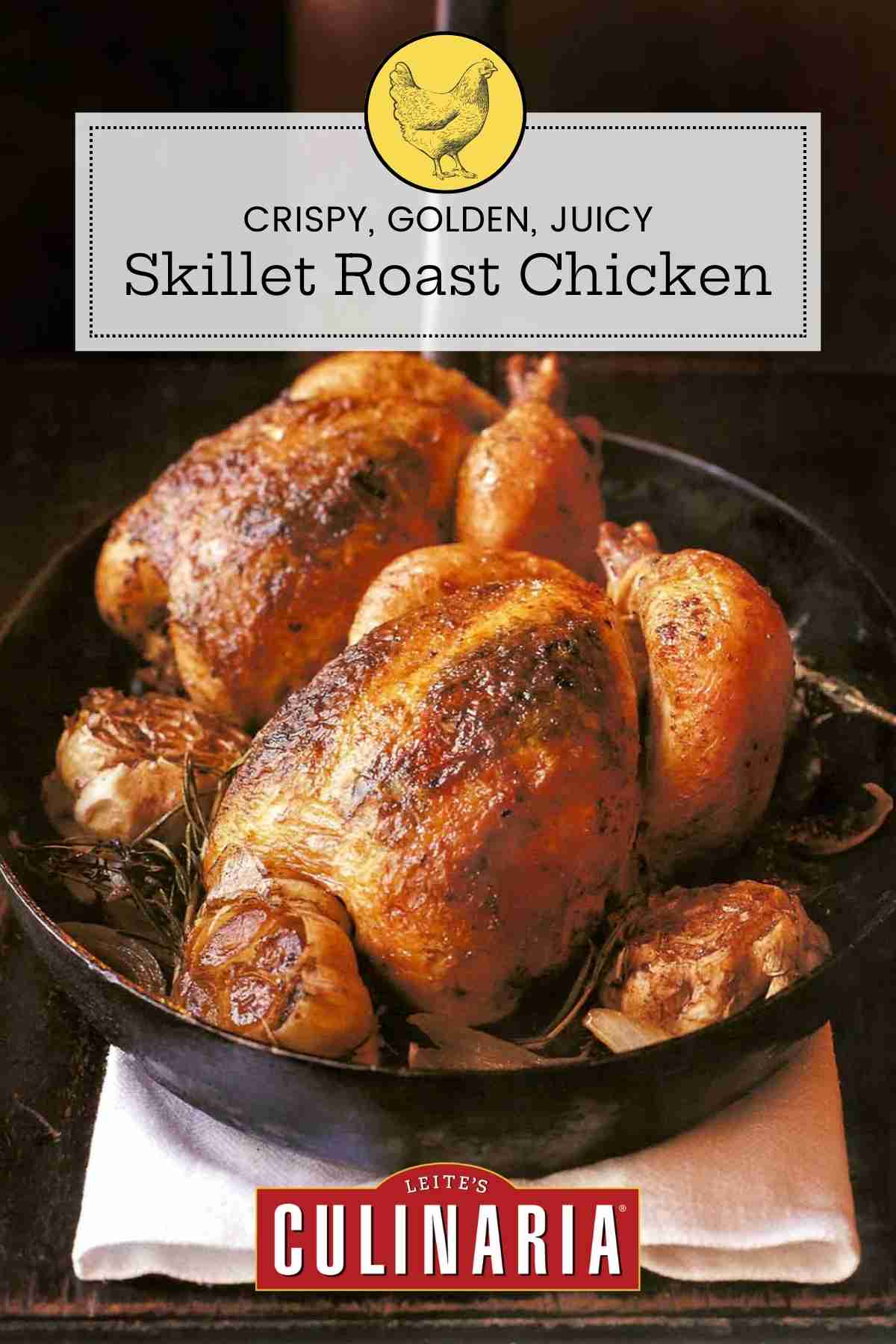
When making this at home we suggest throwing in some diced vegetables–like carrots, celery root, and mushrooms—along with the chicken, making it a very simple supper. (If including diced vegetables in the pan for a one-pot meal, sauté them in some olive oil over a medium flame until somewhat softened, about 10 minutes. Then push the vegetables to the side of the pan, place the chicken in the center, continue with the directions below.)
LC Roast Chicken for Four Note
This mind-bendingly moist hen with preternaturally crisp skin is the happy consequence of a super simple equation: Smallish hen + super hot oven = well, we already sort of gave it away. Ordinarily, a single hen ought to serve four, although this technique turns out a bird so lovely, it’s best not to leave it to chance. We suggest you instead roast two birds at once, snuggled side by side, in a largish pan. However many hens you roast, don’t forget to clean the oven first, lest any runover remnants from last October’s apple pie trigger your smoke alarm. Oh, and the results work the same regardless of whether you slather the hen silly with the herb butter specified in the recipe below or simply douse it with a little olive oil and coarse sea salt. Think we’re overhyping the recipe? Try it.
Want to Make Gravy?
Wait! Don’t toss those drippings. See those caramelized brown bits at the bottom of the pan? Those are flavor bombs. If you want to turn them into liquid gold—without a single lump—watch my new video on How to Make No-Fail Pan Gravy. It comes together in 15 minutes while the bird rests.
Want to Save This?

Skillet Roast Chicken
Ingredients
- 3 sprigs rosemary, finely chopped, plus more for garnish
- 6 sprigs thyme, finely chopped, plus more for garnish
- 8 sprigs flat-leaf parsley, finely chopped
- 4 tablespoons butter, at room temperature
- 1/8 teaspoon plus 1/2 teaspoon salt
- 1/8 teaspoon plus 1/4 teaspoon freshly ground black pepper
- One (3 1/2- to 4-pound) chicken, rinsed and dried, wings snipped at the elbow
- 3 heads garlic, split horizontally
- 3 tablespoons olive oil
Instructions
- Preheat the oven to 450°F (232°C).
- In a small bowl, mash half the rosemary, thyme, and parsley with the softened butter with a fork. Season with 1/8 teaspoon of the salt and 1/8 teaspoon of the pepper. Use your fingertips to slide the herbed butter beneath the skin of the breasts, starting at the opening near the neck and sliding it as far as possible beneath the skin. Stuff the cavity with the remaining chopped herbs and 1 head of garlic. Season with 1/2 teaspoon of salt and 1/4 teaspoon of pepper.
- Heat the oil in a heavy ovenproof sauté pan over medium-high heat until hot but not smoking.If you wish to sear the bird prior to roasting, truss the chicken with butcher’s twine*. Place the bird on its side in the skillet, searing the leg and breast. Leave it untouched in the pan for at least 4 minutes, turning only when the bird is burnished brown. Turn to brown the other breast side, and then the top and bottom of the bird so that it is well-browned on all sides. Spoon off the excess fat.If you don't wish to sear the bird prior to roasting, place the chicken in the skillet, breast side up.
- If desired, strew a couple sprigs of rosemary and thyme in the pan and place the remaining 2 heads garlic around the bird. Transfer the skillet to the oven. Roast until the chicken is cooked through, basting occasionally with the pan juices, for about 40 minutes. The bird is done when when the juices run clear from the joint between leg and thigh. If the bid’s skin begins to burn, cover with an aluminum-foil tent. Let stand at least 10 minutes prior to carving.*Trussing a chicken note: To hold its shape and allow for even stovetop browning, it's important to properly truss the bird. Its upper wings are held tight against the body and the legs are crossed and bound at what would be the ankles. Begin by rinsing and drying the chicken, and then snipping the wings off at the elbow joint; discard or freeze the wing tips to make a stock. Lay a piece of kitchen twine, about 36 inches long, across a cutting board and place the chicken in the middle of the string. Pull the string up on both sides so that it draws the wings up against the bird's body. Bring each side of the string down along the breasts and pull snugly so the string tucks between the breast and the leg on each side. Wrap each piece of the string around the opposite ankle, then pull the string taut so the ankles are crossed and closed over the cavity. Tie the string very lightly and snip off any excess. The bird should now be snug, tight, and roundish.

Explore More with AI
Nutrition
Nutrition information is automatically calculated, so should only be used as an approximation.
Recipe Testers’ Reviews
I roasted the chicken without searing it first, and exactly 40 minutes later, the chicken came out looking gorgeous. The skin was golden and crispy, and the meat was so juicy—perfectly done. (My chicken weighed 3 1/2 pounds, and it was close to room temperature when it went into the oven.) The roasting pan didn’t have enough jus to make a sauce, but the moist chicken wasn’t screaming for it, either. Another thing this roast chicken can do without is parsley—it was overpowered by the rosemary and thyme, and, quite frankly, I didn’t miss it. TIP: Save the carcass—with all of the herbs and garlic, it’ll make a lovely stock for later use.
Things got a little messy when rubbing the herb butter under the chicken’s skin, but I did it, and trussed the chicken without too much trouble. A good portion of butter oozed out of the chicken and into the pan—I’m not sure it’s supposed to do that, but it certainly made for a richer pan sauce. I left the chicken in the oven for an extra 15 minutes because the inner thigh meat was still pink, and even with the extra time, the breast meat was still moist and infused with herb flavor, with a hint of garlic. The skin all over the bird (except for underneath) was exceptionally crisp and delicious. (I don’t think I missed anything by not searing the chicken beforehand.) I’ve cooked chickens at all sorts of temperatures, but I’d go with this high temperature because it guarantees crispy skin without suffering the breast meat. I later mixed the leftovers into a gravy for chicken pot pie.
This dish is almost as good as the Peruvian Roasted Chicken. I was worried the rosemary and thyme would overwhelm the chicken, but they added such wonderful flavors! I did try the jus, but wasn’t crazy about it. The leftovers are also good in stir fried rice the next day.
I made this a one-pot meal as suggested by adding potatoes, carrots, celery, pearl onions, and mushrooms. First, I diced the potatoes and microwaved them for 5 minutes to give them a head start, then I sautéed the vegetables in a little olive oil until they were slightly softened. I placed the chicken in a pot and arranged the vegetables around it, sprinkling on more herbs. It cooked for 40 minutes, tented, with occasional basting. The chicken’s aroma filled my house, making everyone hungry! When it was done cooking, I removed the chicken from the pot and added a 1/2 stick of butter, allowing it to melt over the vegetables. My guests commented on how good this chicken was, that the herbs perfectly complemented the chicken. Everyone went back for seconds. I’ll definitely make this again, next time adding 1/2 cup of white wine to the pot, which would further enhance this already outstanding chicken dish.
This is now my favorite roast chicken recipe. It’s simple, yet it results in a dish that appears to have involved more fuss than was actually required. I sautéed some diced potatoes, onions, carrots, and mushrooms in the pot before I placed the chicken in the oven. This resulted in a one-pot meal with lots of great flavor. The only issue was that there wasn’t enough liquid in the pot to baste the chicken while it was roasting, so I added 1/2 cup of water. This was also enough liquid for a nice pan sauce: I simply removed the chicken and vegetables and added about 1 tablespoon of butter to the pot. This resulted in a tasty, smooth sauce to pour over the chicken and vegetables. The 40-minute roasting time was perfect for my chicken, which was just under 4 pounds. It wasn’t necessary to sear the chicken beforehand—with the high heat, the chicken browned very nicely. I had plenty of food leftover for another meal for two.
What a delicious chicken. Preparation for this dish was straightforward and easy, yielding moist and flavorful results. The coating of chopped herbs made for a very pretty presentation, and I’m sold on making a flavorful butter mixture to go under the chicken’s skin. Searing the bird in a hot cast-iron skillet also gave it a lovely mahogany color. Partway into cooking, however, our kitchen filled with a cover of haze—we needed to open the windows, downstairs and up (450 degrees makes for a hot oven, especially mixed with chicken fat).
I’d like to see more information provided in the recipe for trussing, and for when the bird is done. Though the directions for trussing were good, the recipe should specify which side of the bird you place on the twine before trussing—we put the wrong side down on our first attempt, and didn’t realize it until we were going through the other steps. As for when the bird was done, the juices ran clear from the joint between the leg and thigh, so we thought it was done. (The thigh temperature was also 187 degrees.) While carving, we saw some red juices, and one of the chicken’s breast meat was raw. It was very bizarre—I’ve never seen anything like it. However, despite that oddity, the chicken that we could eat tasted amazing.
Let’s face it, some roast chicken recipes produce dry, bland birds. That’s not the case, however, with this Roast Chicken for Two. The herbed butter was very flavorful, and the bird was moist—even the white meat, and even though it was necessary to bake my 3 1/2-pound chicken for an additional 15 minutes. I didn’t brown the bird prior to roasting, as maneuvering a whole chicken to get even browning is almost impossible. Preheating the pan produced a chicken with brown, crispy skin. After skimming the grease, I had just the right amount of juice to make a great pan sauce.
My entire family agreed that these were some of the best roast chickens I’ve ever made. The flavor combination of the fresh rosemary, thyme, parsley, garlic, and butter was perfect. I roasted two birds that were close to 4 pounds each. I don’t know if this increased the cooking time, but it took 75 minutes to reach the desired 165 degrees in the meaty portion of the chicken thigh. We’ll definitely make this again.
I knew right away that this was a nice chicken dinner that can be thrown together in a few minutes—a careful easing of the herbed butter under the skin was all it took. The aroma from the oven made it hard to wait for the hen to come out of it, but the wait was worth it. While we surely enjoyed the flavor, I did have a problem with the butter splattering on the sides of the oven, so next time I’ll use a deeper roasting pan. For my taste, the bird needed more salt than the recipe called for, and the garlic needed additional roasting, as it was still very firm. But the chicken was tender, juicy and full-flavored.
Wow, I loved this chicken! It was so simple to prepare. The chicken was prepared easily, smelled amazing, and was done in no time. The combination of herbs, garlic, and butter was very traditional, yet superb. TIP: Make sure that the pan that the chicken will roast in is large enough, as there’s quite a lot of juice that cooks out of it, and mine was close to spilling over. I’ll make this again and again.















Hello David,
May I please ask that when cooking anything in the oven such as a roast chicken it be stated in the recipe whether or not the pan should be covered.
Thank you & regards,
Lloyd
Lloyd, it depends. Sometimes you cover the pan because you want to keep the moisture in, and you don’t want any liquid to evaporate. Other times, you want to take the cover off to encourage browning and prevent the liquid from evaporating.
A good recipe should state whether it’s covered or not. If it doesn’t say, go with uncovered.
Please do not tell people to wash raw chickens. The CDC does not advise it. https://www.cdc.gov/foodsafety/chicken.html
Thanks, Daniel.
This is one of the most fun ways to roast a chicken and bring something that looks good and tastes even more glorious to the table.
I have done it both ways – no searing, and searing. I have found, however, that if you are prone to “oven incendiaries” you might turn the oven down to 350 after the first 15 minutes. There can be a lot of splattering going on if you use a cast iron skillet. I also found that my chicken needed a few more minutes in the oven if I turn the heat down.
Give this recipe a try and you will be a convert! The combination of herbs is magic and you will be touted as the Kitchen Wizard when you serve this delightful rendition of roast chicken.
Karen